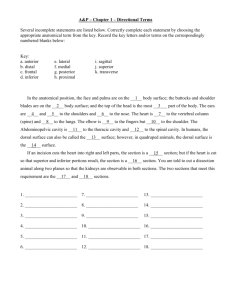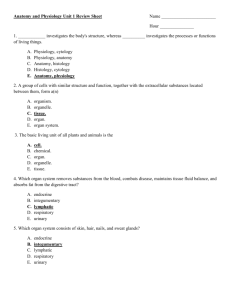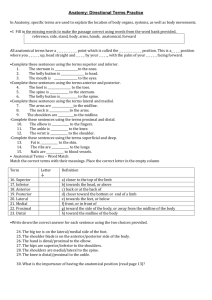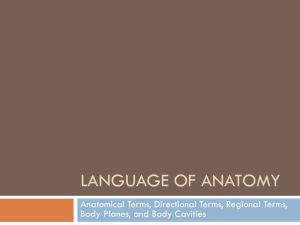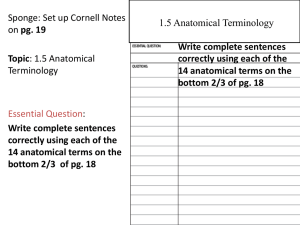Anatomy and Physiology Unit 1 Review Sheet Chapter 1 Name ________________________
advertisement
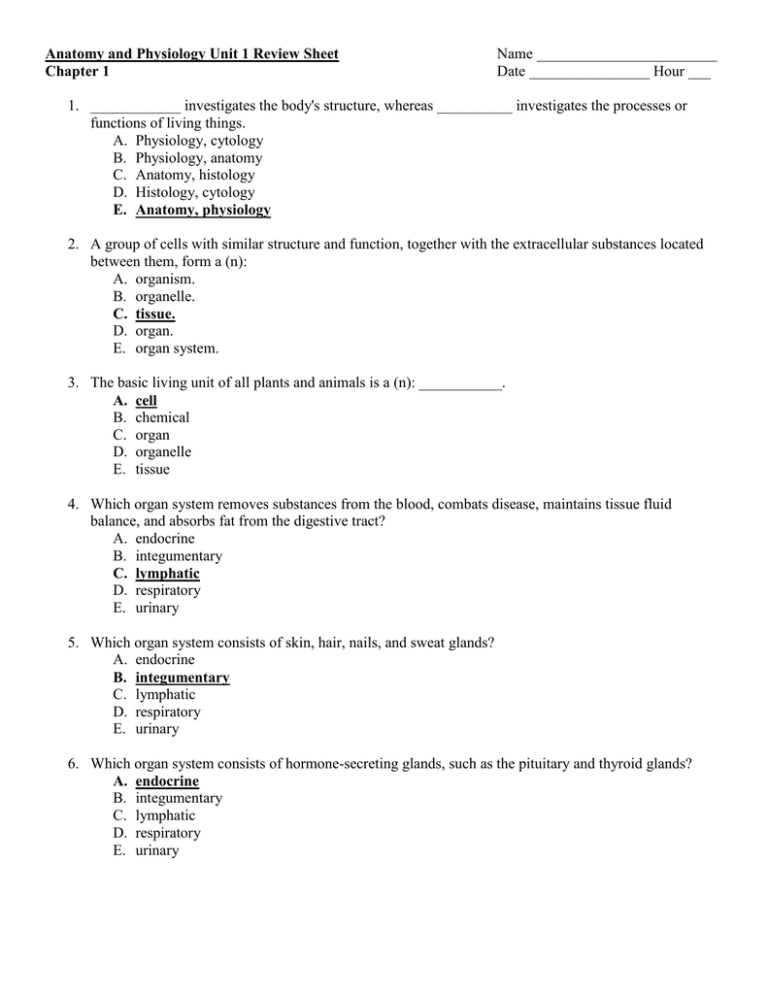
Anatomy and Physiology Unit 1 Review Sheet Chapter 1 Name ________________________ Date ________________ Hour ___ 1. ____________ investigates the body's structure, whereas __________ investigates the processes or functions of living things. A. Physiology, cytology B. Physiology, anatomy C. Anatomy, histology D. Histology, cytology E. Anatomy, physiology 2. A group of cells with similar structure and function, together with the extracellular substances located between them, form a (n): A. organism. B. organelle. C. tissue. D. organ. E. organ system. 3. The basic living unit of all plants and animals is a (n): ___________. A. cell B. chemical C. organ D. organelle E. tissue 4. Which organ system removes substances from the blood, combats disease, maintains tissue fluid balance, and absorbs fat from the digestive tract? A. endocrine B. integumentary C. lymphatic D. respiratory E. urinary 5. Which organ system consists of skin, hair, nails, and sweat glands? A. endocrine B. integumentary C. lymphatic D. respiratory E. urinary 6. Which organ system consists of hormone-secreting glands, such as the pituitary and thyroid glands? A. endocrine B. integumentary C. lymphatic D. respiratory E. urinary 7. Which of these characteristics of life helps maintain homeostasis when environmental conditions change? A. growth and development B. metabolism C. organization D. reproduction E. responsiveness 8. Given these terms related to negative-feedback: 1. control center 2. effector 3. receptor 4. response 5. stimulus.Arrange them in the correct order as they operate to maintain homeostasis. A. 1,2,3,4,5 B. 2,3,5,1,4 C. 3,2,1,5,4 D. 4,5,3,2,1 E. 5,3,1,2,4 9. Which of these processes illustrates positive-feedback? A. increase in respiratory rate during exercise B. increase in heart rate when blood pressure decreases C. shivering when body temperature decreases D. increase in uterine contractions when uterine stretching increases during childbirth E. all of these 10. Failure of negative-feedback mechanisms to maintain homeostasis A. may produce disease. B. occurs when blood pressure increases during exercise. C. can be corrected by stimulating positive-feedback mechanisms. D. cannot be corrected by medical therapy. E. all of these 11. To maintain homeostasis, the normal range of values for a variable A. is always below the set point. B. may change in different situations. C. may not deviate from the set point. D. occurs because of positive-feedback. 12. A term that means "away from the midline" is: A. distal B. lateral C. medial D. proximal E. superior 13. Which of these descriptions does NOT apply correctly to a person in the anatomical position? A. standing erect B. head facing forward C. feet facing forward D. arms hanging to the side E. palms facing toward the thighs 14. The scapula (shoulder blade) is __________ to the lung. A. dorsal B. posterior C. superficial D. all of these 15. The elbow is __________ to the wrist. A. distal B. superior C. lateral D. medial E. proximal 16. The nose is __________ and __________ to the ears. A. anterior, proximal B. superior, lateral C. inferior, posterior D. anterior, medial E. superficial, medial 17. Which of the paired terms below are opposites? A. anterior and cephalic B. posterior and cephalic C. posterior and caudal D. superior and cephalic E. anterior and dorsal 18. Pancreatitis describes: A. inflammation of the pancreas. B. removal of the pancreas. C. cancer of the pancreas. D. secretions from the pancreas. E. death of the pancreas. 19. Which of these anatomical terms refers to the ankle? A. manus B. femoral C. carpal D. inguinal E. tarsal 20. Which of these anatomical terms refers to the ball of the shoulder? A. deltoid B. brachial C. cervical D. buccal E. digital 21. The only plane that can divide the body into equal halves is the ____________. A. frontal (coronal) plane B. oblique plane C. mid-sagittal plane D. transverse plane E. Serengeti plane 22. A (n) __________ plane divides the body into superior and inferior portions. A. frontal (coronal) B. oblique C. sagittal D. transverse 23. What is another name for the frontal plane? ______Coronal________ 24. Which of these statements concerning body regions is correct? A. The pelvis is located between the thorax and abdomen. B. The leg extends from the knee to the ankle. C. The arm extends from the shoulder to the wrist. D. The trunk can be divided into the thoracic area and pelvis. 25. The cavity surrounded by the rib cage and bordered inferiorly by the diaphragm is the A. pericardial cavity. B. thoracic cavity C. abdomen. D. pelvic cavity. 26. Homeostatic imbalance has occurred when a A. person shivers as a result of being cold. B. person's heart rate increases as a result of exercise. C. person sweats as a result of being hot. D. person's breathing rate increases as a result of exercise. E. person becomes ill. 27. Select the option that shows increasing complexity levels. A. Organ system, organ, tissue, cellular B. Cellular, tissue, organ, organ system C. Organ, tissue, cellular, organ system D. Cellular, tissue, organ system, organ E. Tissue, organ, organ system, cellular 28. The opposite of superior is ______________. A. lateral B. inferior C. ventral D. distal E. superficial 29. Which choice below is NOT one of the three components of homeostatic control systems? A. The control center B. The effector C. Stimulus (cause of the initial change) D. Receptor (senses the change) 30. The respiratory system contains the A. liver, small intestine, and colon. B. kidneys, ureters, and bladder. C. trachea, bronchi, and lungs. D. pituitary, pineal, and thyroid glands. E. uterus, vagina, and uterine tube. 31. Which of the following body systems acts as a fast-acting control system for the body? A. Reproductive B. Skeletal C. Respiratory D. Endocrine E. Nervous 32. Which of the following body systems functions to produce blood cells? A. Digestive B. Reproductive C. Skeletal D. Respiratory E. Urinary 33. Which of the following is NOT a necessary human life function? A. Excretion B. Responsiveness C. Movement D. Intelligence E. Metabolism 34. Which one of the following is NOT a survival need? A. Atmospheric Pressure B. Food C. Water D. Transportation E. Oxygen 35. The ability to sense changes in the environment and respond to them is a physiological ability known as A. excretion B. responsiveness C. metabolism D. digestion 36. All of the following are correct positioning when placing the body in the anatomical position except A. the feet are slightly apart. B. the palms are facing forward. C. the body is "standing to attention". D. the thumbs are pointing medially. 37. Which of the following organs lies in the dorsal cavity? A. the lungs B. the kidney C. the spinal cord D. the stomach Give the “opposite” for each of the following directional terms. 38. caudal – Superior/Cephalic 39. lateral - Medial 40. distal - Proximal 41. inferior - Superior 42. ventral – Dorsal/Posterior 43. superficial - Deep 44. posterior – Anterior/Ventral Circle the answer which will make the sentence correct. 45. The big toe is on the lateral/medial side of the foot. 46. The scapula is on the anterior/posterior side of the body. 47. The hand is distal/proximal to the elbow. 48. The hips are superior/inferior to the shoulders. 49. The shoulders are medial/lateral to the spine. 50. The knee is distal/proximal to the ankle. Complete using the terms superior and inferior. 51. The hands are ______Superior______to the feet 52. The knees are ______Inferior__________ to the waist. 53. The elbow is _____Superior___________ to the wrist. 54. The calf muscle is __Superior___________to the ankle. Complete using the terms anterior and posterior. 55. The heel is ____posterior________ to the toes. 56. The biceps are ______anterior_______ to the triceps. 57. The hamstring is ______posterior___to the quadriceps Complete using the terms lateral and medial. 58. The arms are ____Lateral___________to the midline. 59. The neck is _____Medial_________to the arms. 60. The shoulders are __Lateral_________to the midline.

